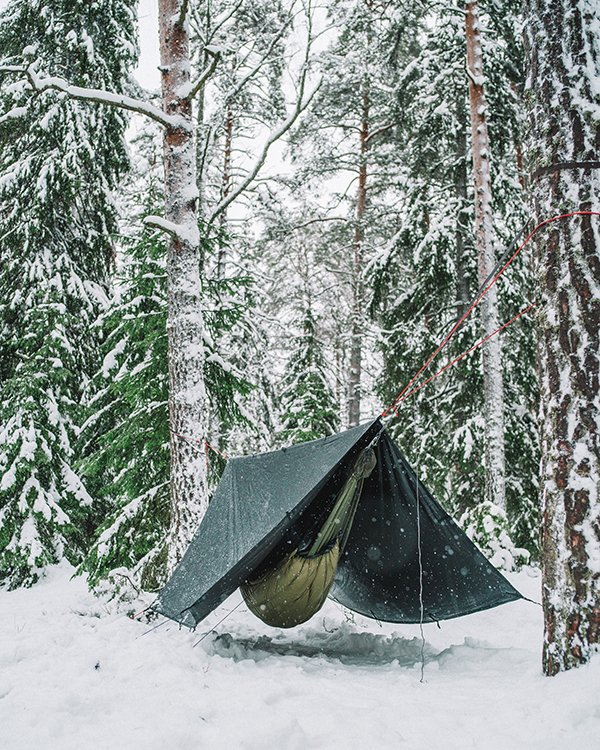There are several benefits to winter camping. There are fewer pests and people, and you can relax and appreciate the beauty and calm of a winter paradise. However, it might be chilly and difficult if you are not prepared. To prepare for a successful winter camping trip, brush up on your fair-weather camping skills while adapting to the added obstacles of freezing temperatures, snowy terrain, and unpredictable weather.
Cold temperatures are unavoidable while camping in the winter. But don’t allow cold fingers and toes to deter you from going on that overnight ski excursion or snowshoe adventure. You can keep warm when winter camping and get the rest you need to charge hard on the following day’s goal with the correct tips and methods.
Hammock campers may sleep peacefully during chilly winter evenings with the appropriate method. It’s known as “cold butt syndrome.” When you sleep in a hammock, the regions of your body that are in contact with the fabric get chilly because they are more vulnerable to wind.

It would be best if you take additional precautions to remain warm when hammock camping in the cold. Below are good winter camping suggestions based on experience and guidance from hammock users.
1. Plan Ahead of Time
Prepare for your cold weather campout like any other outdoor trip. Examine the weather prediction, paying special attention to aspects such as nightly low temperatures, impending storm systems that might bring rain or snow, and other potentially severe situations such as strong winds. Then, customize your adventure gear to tackle anything that comes your way.
Packing warmer clothing layers to battle freezing nighttime temperatures, taking an extra ground cover to deal with wet weather, or carrying extra guylines to assist in maintaining your tent in the event of strong winds and heavy rain or snow are examples of what this entails.
2. Select a Suitable Location
Look for a campground close to two trees or other anchor points. A position with a natural wind barrier, such as near a huge rock or in a thick forest, is essential in the winter. Avoid regions where cold water collects at night, such as basins and other areas lower than the rest of the ground.
3. Install Your Hammock
Begin by firmly tying your hammock tree straps to two trees around 10 feet apart. For the greatest hammock hang angle for restful sleep, your hammock should droop to around 18 inches off the ground with you inside. Before setting up your rainfly or hammock tarp, place your sleeping pad and bag inside the hammock.
4. Explore Natural Shelter and Think About the Wind
One of the primary goals of hammock setup is to cope with anticipated wind. Take notice of the wind direction and use natural windbreaks such as hills, rock formations, and trees. Instead of hanging your hammock in an open place, bring it near a cluster of trees and benefit from their natural shielding effect. As an additional layer of protection, you may also try putting a tarp between two trees.
5. To Keep Warm, Use Quilts
Use an under-quilt, insulated blanket that you thread up under your hammock to help trap heat and prevent wind. This forms an air layer between the blanket and the hammock, trapping heat and providing additional insulation. You’ll be warmer if you use an under quilt instead of simply a sleeping bag inside your hammock. The insulation of a sleeping bag compresses and loses its capacity to retain heat in a hammock.
While a sleeping bag will still provide enough insulation for the top of your body, many hammock campers eschew the bag in favor of a top blanket designed expressly for a hammock. Top quilts are often light and collapsible, making them easier to transport into the bush.
6. Apply a Sleeping Pad
Another option is an underpad, which you lay underneath the hammock instead of an under blanket. You may use a conventional foam or inflatable sleeping pad, but keep in mind that these can slip and even slide out of the hammock as you move while sleeping. Some hammocks contain an interior compartment that keeps a foam or inflatable sleeping pad from moving.
Another option is to get a hammock-specific pad. These include side portions that fold to create a hammock and materials that reflect your body heat. Sleeves that go over a pad and include reflective elements to assist you in maintaining heat are also available.
7. Set up a Tarp Above the Hammock
A tarp rigged over your hammock may prevent wind, rain, and snow while simultaneously trapping heat. Keep in mind that you should place the tarp as low as feasible. Pull the tarp corners as low as possible and fasten them after you’ve secured them on the tree immediately above the hammock straps. Rainfly and tarps from various hammock manufacturers are available on the market.

8. Place Your Head on a Pillow
To remain warm in the cold, avoid pushing your skin against the hammock cloth as much as possible. Pack a travel cushion and cover your neck and shoulders when sleeping.
9. Layers of Clothing
Wear many layers while camping in the cold, even using a hammock. This will help you to manage your temperature and avoid being excessively hot or chilly. You’ll even be able to add and remove garments without leaving the comfort of your hammock with a little practice.
It’s a good idea to have additional clothes inside your hammock to keep it warm and accessible. Also, remove any snow from your clothes before getting into your hammock. While it may seem apparent, it may make a significant difference in keeping you dry and comfortable.
10. Key in the hot water Bottle
Fill an insulated hot water bottle before bed and keep it by your feet, as hangers have done for years. This will keep your whole body warm throughout the night.
Conclusion
If you arrive prepared, winter hammock camping may be an incredible experience. Invest in the proper hammock camping equipment, wear warm winter clothes, and choose a well-sheltered area for the greatest results. I suggest carrying a tent for beginners just in case winter hammock camping isn’t for everyone. You don’t want to be caught in an unpleasant scenario if you discover you are one of these individuals!

